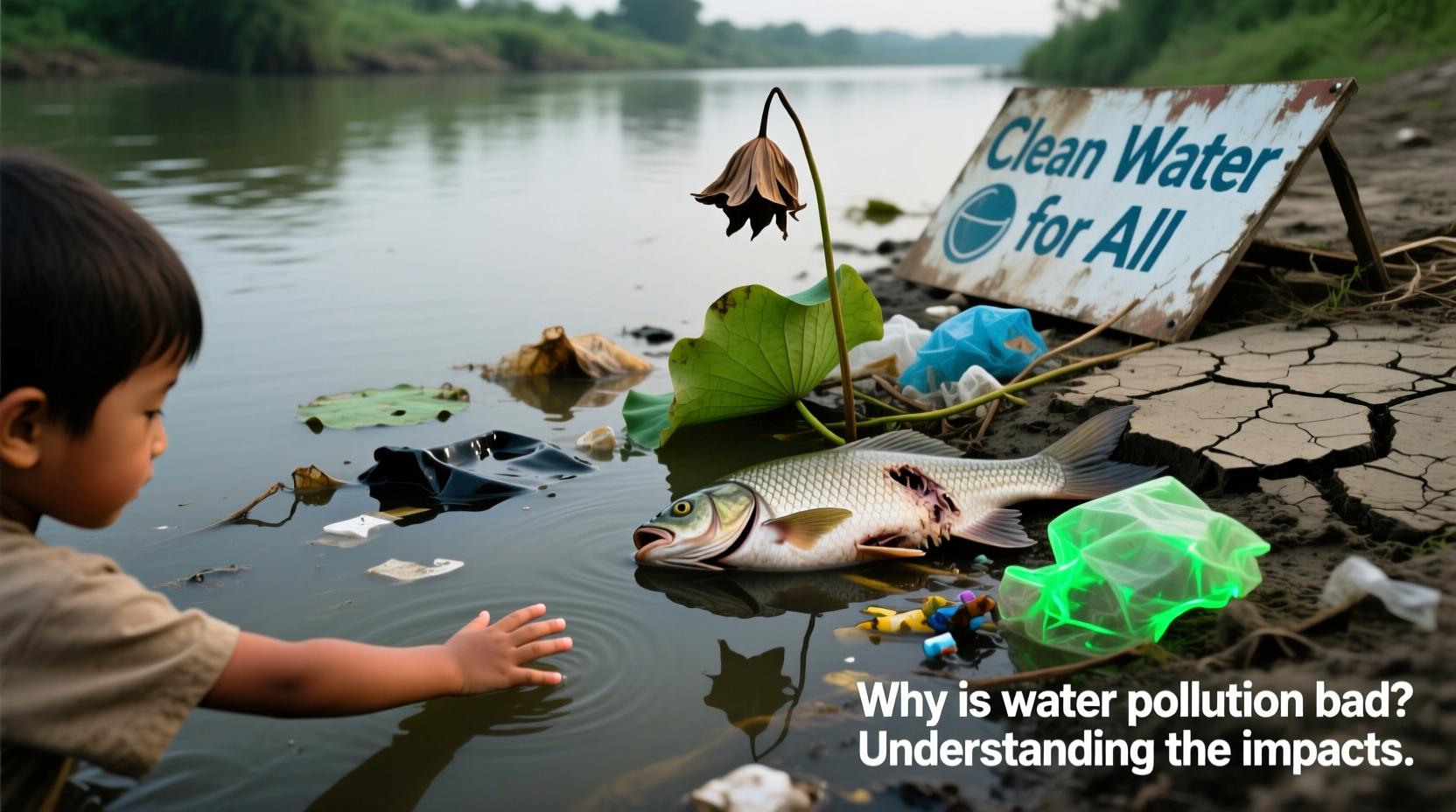Water is essential to life on Earth. It sustains ecosystems, nourishes crops, supports industry, and keeps human populations healthy. Yet, across the globe, freshwater and marine environments are being compromised by pollution. From industrial discharge to agricultural runoff and plastic waste, the contamination of water bodies has far-reaching consequences. Understanding why water pollution is bad requires a deep look at its effects on human health, biodiversity, economies, and climate stability. This article explores these impacts in detail, offering actionable insights and real-world context to underscore the urgency of protecting our water resources.
Environmental Consequences of Water Pollution

Water pollution disrupts aquatic ecosystems in profound ways. When harmful substances—such as heavy metals, pesticides, pharmaceuticals, and excess nutrients—enter rivers, lakes, and oceans, they alter the natural balance of these environments. One of the most visible outcomes is eutrophication, a process triggered by excessive nitrogen and phosphorus from fertilizers and sewage. These nutrients cause algal blooms that deplete oxygen levels in the water, creating \"dead zones\" where fish and other marine life cannot survive.
Aquatic species are particularly vulnerable to chemical pollutants. For example, mercury from industrial emissions accumulates in fish tissues through bioaccumulation, moving up the food chain and reaching dangerous concentrations in top predators like tuna and sharks. Even low-level exposure to endocrine-disrupting chemicals can interfere with reproductive systems in fish, amphibians, and birds, leading to population declines.
“Contaminated water is not just an environmental issue—it’s a crisis that undermines the stability of entire ecosystems.” — Dr. Lena Torres, Marine Ecologist, Scripps Institution of Oceanography
Human Health Risks from Polluted Water
The link between water pollution and public health is undeniable. According to the World Health Organization (WHO), over 2 billion people globally consume drinking water contaminated with feces, putting them at risk of diseases such as cholera, dysentery, typhoid, and polio. In developing regions, inadequate sanitation infrastructure allows pathogens to enter water supplies, resulting in millions of preventable deaths each year—particularly among children under five.
Beyond microbial contamination, chemical pollutants pose long-term health threats. Exposure to arsenic in groundwater—common in parts of Bangladesh and India—can lead to skin lesions, cancer, and cardiovascular disease. Similarly, nitrates from agricultural runoff have been linked to blue baby syndrome, a potentially fatal condition in infants. Even in developed nations, aging pipes and insufficient wastewater treatment can introduce lead, PFAS (\"forever chemicals\"), and microplastics into tap water, raising concerns about chronic illness and developmental issues.
Common Waterborne Diseases and Their Causes
| Disease | Pathogen Source | Symptoms |
|---|---|---|
| Cholera | Fecal contamination | Severe diarrhea, dehydration |
| Hepatitis A | Virus in untreated water | Liver inflammation, fatigue |
| Giardiasis | Parasite (Giardia lamblia) | Cramps, nausea, diarrhea |
| Methemoglobinemia | Nitrate contamination | Oxygen deficiency in blood |
Economic Costs of Water Degradation
Polluted water imposes significant financial burdens on societies. Industries dependent on clean water—including agriculture, fisheries, tourism, and manufacturing—face increased operational costs and reduced yields. For instance, algal blooms in lakes can shut down recreational activities, costing local economies millions in lost revenue. In coastal regions, coral reef degradation due to pollution and warming waters diminishes fish stocks and reduces dive tourism appeal.
Treatment of contaminated water also strains municipal budgets. Removing emerging contaminants like pharmaceuticals and microplastics requires advanced filtration technologies that many cities cannot afford. Additionally, healthcare expenses rise when communities suffer from water-related illnesses, further diverting public funds from education, infrastructure, and development.
Mini Case Study: The Flint Water Crisis
In 2014, Flint, Michigan switched its water source to the Flint River to cut costs, but failed to apply proper corrosion control. The untreated water leached lead from aging pipes, exposing thousands of residents—especially children—to toxic levels. The crisis led to widespread health issues, loss of public trust, and over $600 million in federal aid for pipe replacement and medical services. Flint exemplifies how short-term cost-cutting can result in long-term economic and social devastation.
Impact on Climate and Natural Systems
Water pollution exacerbates climate change and vice versa. Warming temperatures increase the frequency and intensity of algal blooms, while melting glaciers release trapped pollutants into rivers and oceans. Moreover, degraded wetlands—often drained or polluted—lose their ability to sequester carbon and buffer against floods, reducing resilience to extreme weather events.
Ocean acidification, driven by excess CO₂ absorption, is worsened by nutrient runoff that lowers pH levels further. This harms shell-forming organisms like oysters and plankton, disrupting marine food webs. As these foundational species decline, so too do the fisheries and ecosystems that depend on them.
Action Plan: How to Reduce Water Pollution
Addressing water pollution requires collective action at individual, community, and policy levels. Below is a practical checklist to help mitigate personal and societal contributions:
- Dispose of household chemicals, medications, and oils properly—never pour them down drains.
- Use eco-friendly detergents and avoid phosphate-based cleaning products.
- Install rain barrels and permeable driveways to reduce stormwater runoff.
- Support organic farming practices that minimize synthetic fertilizer use.
- Advocate for stronger regulations on industrial discharges and plastic production.
- Participate in local watershed monitoring programs or citizen science initiatives.
Step-by-Step Guide to Safer Household Water Use
- Test your tap water annually using a certified lab, especially if on a private well.
- Install a NSF-certified water filter designed to remove local contaminants (e.g., lead, chlorine, PFAS).
- Fix leaks promptly to prevent stagnant water buildup and bacterial growth.
- Flush pipes before drinking if water has been sitting for several hours.
- Use reusable bottles instead of single-use plastics to reduce microplastic shedding.
Frequently Asked Questions
Can boiling water remove all pollutants?
No. Boiling kills bacteria and viruses but does not remove heavy metals, nitrates, or chemical contaminants. In some cases, boiling can concentrate certain pollutants like lead.
How does plastic pollution affect water quality?
Plastic breaks down into microplastics that absorb toxins and enter the food chain. These particles have been found in tap water, bottled water, and even rain, posing unknown long-term health risks.
Are urban areas more affected by water pollution than rural ones?
Both face different challenges. Urban areas struggle with sewage overflow and industrial runoff, while rural regions often deal with agricultural pollution and limited wastewater treatment access.
Conclusion: A Call to Protect Our Most Vital Resource
Water pollution is not a distant problem affecting only remote ecosystems or developing nations. It is a global emergency with immediate consequences for health, economies, and planetary stability. Every action—from responsible consumer choices to civic engagement—contributes to cleaner water. By understanding the full scope of water pollution’s impacts, individuals and communities can make informed decisions that safeguard this irreplaceable resource.









 浙公网安备
33010002000092号
浙公网安备
33010002000092号 浙B2-20120091-4
浙B2-20120091-4
Comments
No comments yet. Why don't you start the discussion?